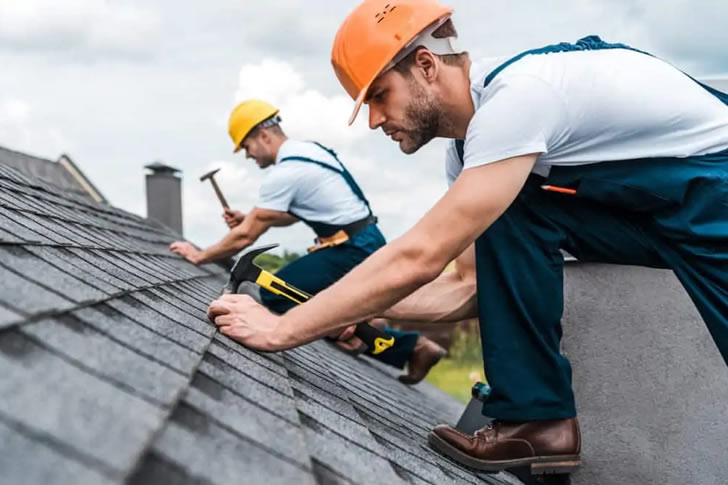Lower Monthly Bills with a Roof Replacement
Replacing your roof can significantly impact your monthly expenses. This’s how investing in a new roof can lead to financial benefits and energy efficiency.

Understanding the Need for Roof Replacement
Roofs are a critical part of any home, protecting against weather elements and ensuring structural integrity. Over time, roofs deteriorate due to factors like weather, age, and poor maintenance. Signs you might need a new roof include:
- Leaks and Water Damage: Persistent leaks and water stains.
- Shingle Damage: Missing, cracked, or curling shingles.
- Sagging Roof Deck: Visible sagging or deformities.
- Increased Energy Bills: Poor insulation leading to higher energy costs.
Benefits of a New Roof
A new roof can offer several benefits beyond just fixing leaks and damage:
- Enhanced Energy Efficiency: Modern roofing materials are designed to provide better insulation, keeping your home cooler in the summer and warmer in the winter. This reduces the strain on your HVAC system and lowers energy bills.
- Increased Home Value: A new roof can boost your home’s market value. According to Remodeling Magazine’s 2020 Cost vs. Value Report, homeowners can recoup about 65% of the cost of a new roof when they sell their home.
- Improved Safety: A sturdy new roof protects against severe weather conditions and prevents structural damage.
Types of Energy-Efficient Roofing Materials
Choosing the right materials for your new roof can maximize energy savings:
- Asphalt Shingles: Cost-effective and available with reflective coatings that reduce heat absorption.
- Metal Roofing: Highly durable and reflects solar radiant heat, reducing cooling costs by 10-25%.
- Tile Roofing: Provides excellent insulation and is ideal for hot climates.
- Cool Roofs: Designed to reflect more sunlight and absorb less heat, keeping your home cooler.
Financial Savings from a New Roof
Investing in a new roof can lead to substantial financial savings over time:
- Reduced Energy Bills: The U.S. Department of Energy states that cool roofs can lower energy bills by up to 15%. If your average monthly energy bill is $200, this could mean savings of $30 per month or $360 per year.
- Maintenance Savings: New roofs require less maintenance, saving on repair costs. Older roofs can require frequent patching and repairs, which add up over time.
- Insurance Benefits: Some insurance companies offer discounts for homes with new roofs due to the reduced risk of damage.
Steps to Replace Your Roof
Here are the steps involved in replacing your roof:
- Inspection and Estimates: Have a professional inspect your roof to determine the extent of the damage and get estimates from multiple contractors.
- Choosing Materials: Select the roofing materials that best suit your needs and budget. Consider energy-efficient options to maximize savings.
- Hiring a Contractor: Choose a reputable contractor with good reviews and proper licensing. Ensure they provide a detailed contract outlining the scope of work and costs.
- Removing the Old Roof: The contractor will remove the old roofing materials and inspect the roof deck for damage.
- Installing the New Roof: New roofing materials are installed, followed by flashing and ventilation systems.
- Final Inspection: After installation, a final inspection ensures everything is properly installed and meets building codes.
Real-World Examples
Here are some real-world examples of homeowners who benefited from roof replacement:
- John’s Experience: John’s energy bills were consistently high due to poor insulation. After installing a cool roof, his summer energy bills dropped by 20%, saving him $50 per month.
- Susan’s Story: Susan noticed leaks and water damage in her attic. Replacing her old roof with energy-efficient shingles reduced her heating costs by 15% during the winter months.
Government Incentives and Rebates
There are various incentives and rebates available to help offset the cost of a new roof:
- Federal Tax Credits: The federal government offers tax credits for energy-efficient home improvements, including roofing.
- State and Local Programs: Many states and local governments provide rebates and incentives for energy-efficient roofing projects.
- Utility Company Rebates: Some utility companies offer rebates for installing energy-efficient roofs.
Conclusion
A new roof is more than just an aesthetic upgrade; it’s a practical investment that can lower your monthly bills and increase your home’s value. By choosing energy-efficient materials and understanding the financial benefits, you can make an informed decision that will pay off in the long run. From reduced energy costs to improved safety and home value, a roof replacement offers numerous advantages that make it a worthwhile investment.







Recent Comments